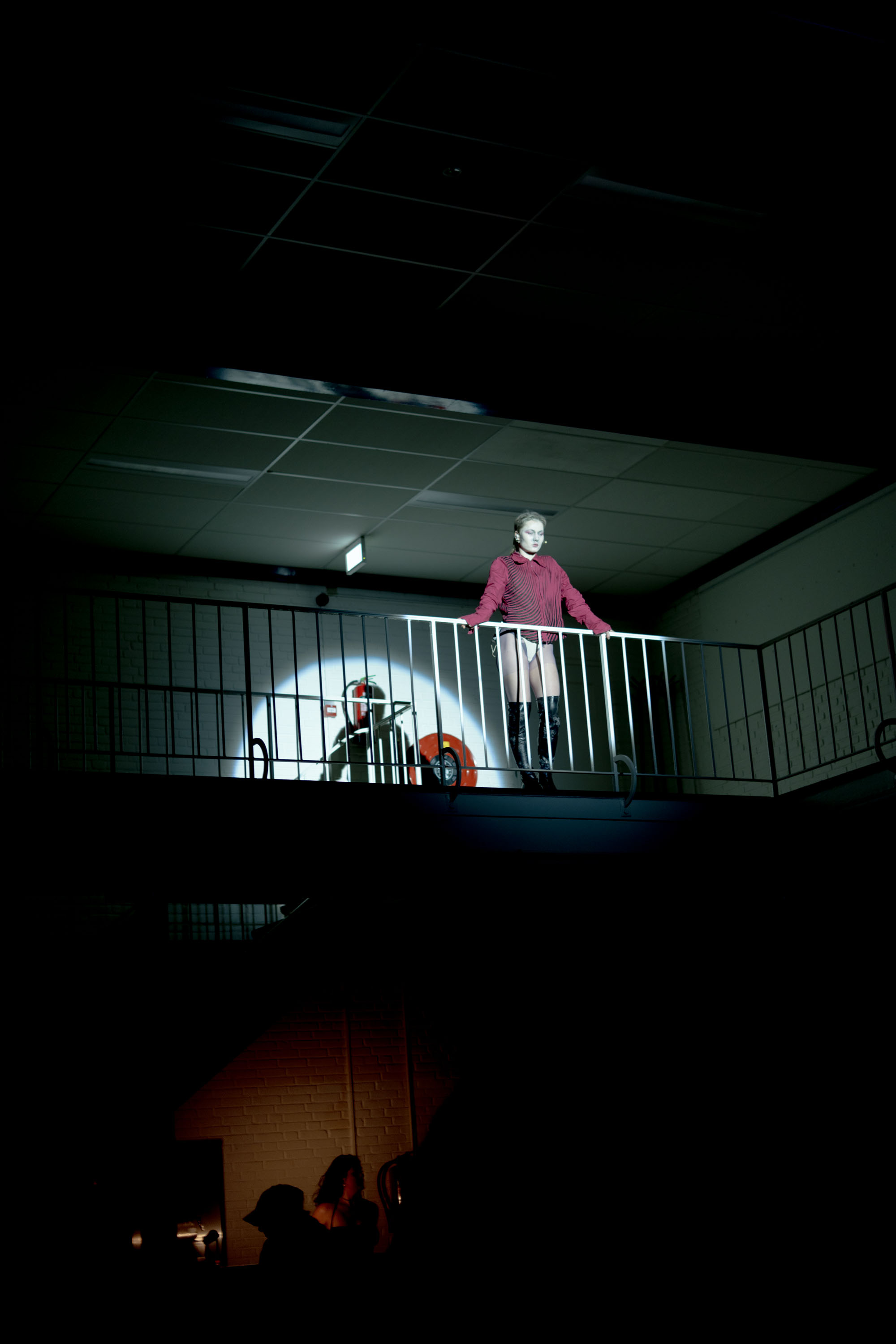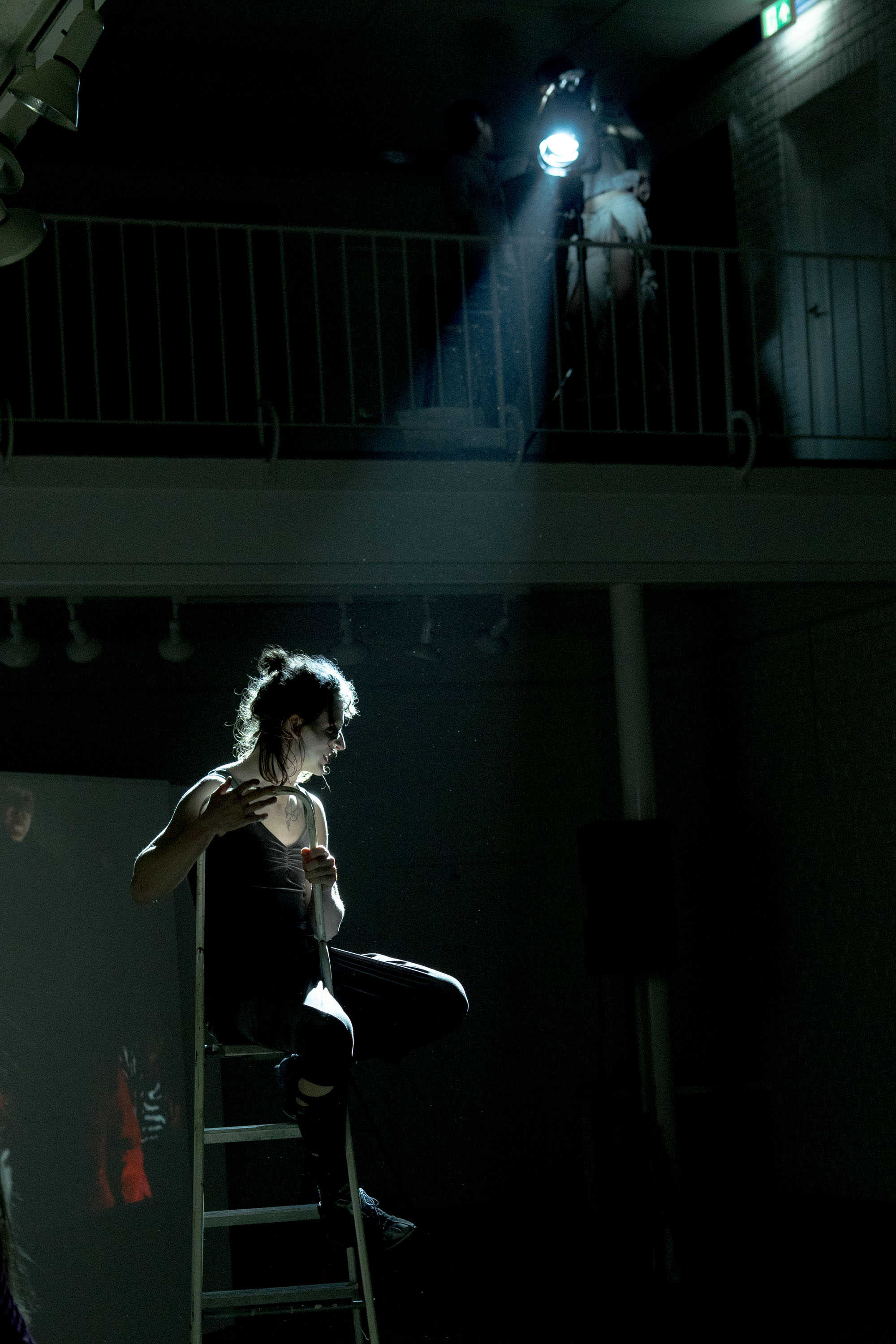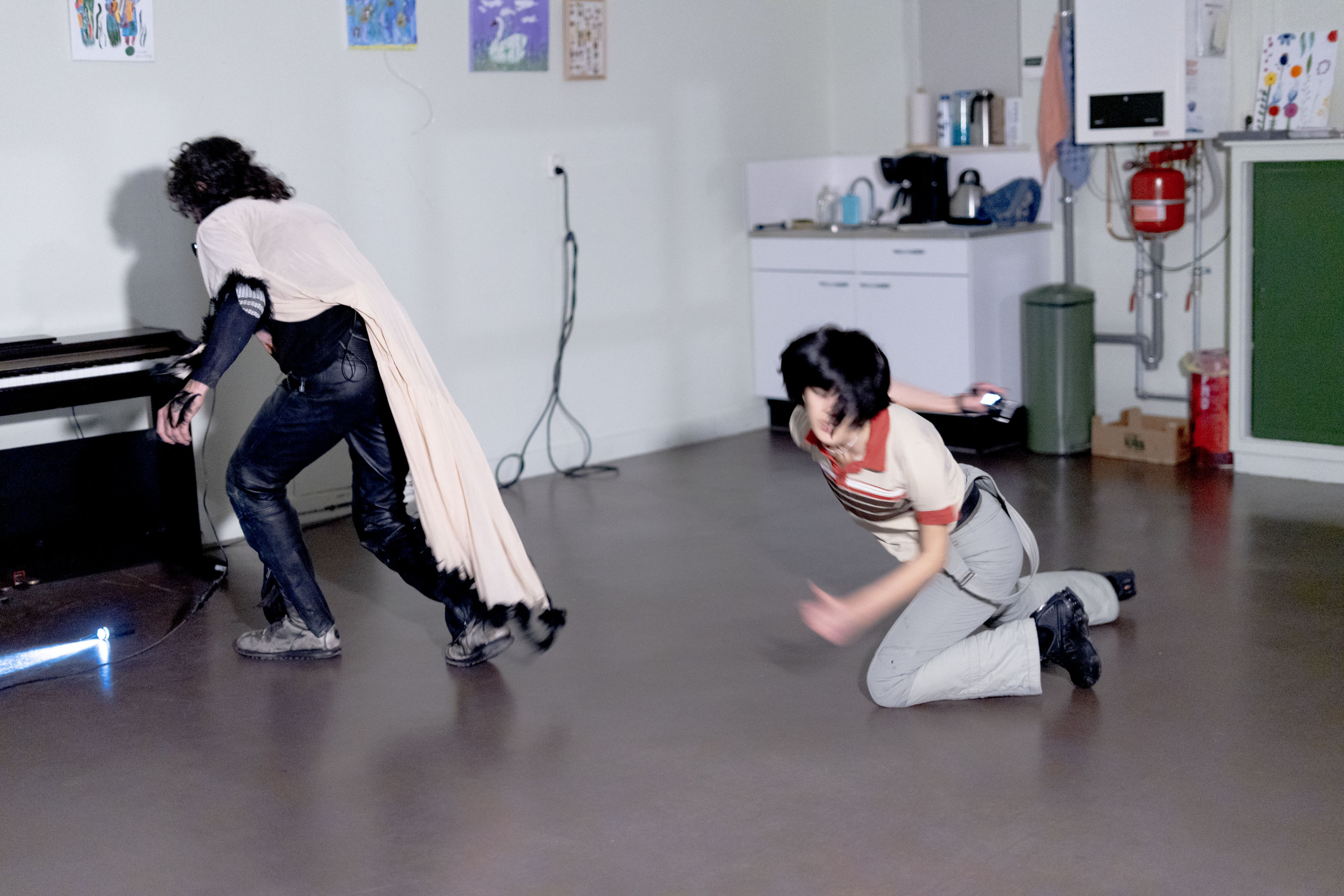Amstelveen Variety Matrix
Ateliers 2005, Amstelveen
19 February 202522-04-2025
Making things seem easy, being charming along the way —what’s not to love about talent? The format of the talent show has been used to its exhaustion, and the reinterpretations preceding and succeeding the American-dream-fueled TV shows inform art. Its best explorations allow for freakiness and excess, from honestly any artists that situate themselves in the lineage of Dadaism, up to and including Florentina Holzinger and Jérôme Bel. It’s always been a post-Simon Cowell world.
Amstelveen Variety Matrix’s (AVM) first and last iteration took place on a Wednesday night at Ateliers 2005, a former school building converted into studio spaces in deep Amstelveen. It consisted of a performance night under the framework of a talent show with horror movie innuendos, organized and hosted by the duo Autism Controller/Solution Hierarchy (AC/SH). Formed by Cameron Lynch and Inka Hilsenbek as artners, you might remember AC/SH from “A Wound is a Wound” at bologna.cc last year or from their parallel individual practices, like Lynch’s publishing project the New Irish Press, and Hilsenbek’s memorable silent horror movie at the Rietveld Graduation ’24.
On the way to Amstelveen, I jokingly bet with my housemates on who else on the bus was heading to the event. We were right and followed the handful of stylish Y2K kids instead of rechecking Maps. As we arrived in the monumental entrance hall, now converted into a stage, an enigmatic drone sound filled the space while a projection oriented the gaze towards a screen made from piled-up MDF structures. Zoomed-in color-inverted images, objects in a messy room full of cigarette butts, and a person gluing fur to their face and speaking with a thick Italian accent appeared on screen. Is that the dressing room or the setting for the worst Feeld date you’ve ever had? And has it even started yet? About ten chairs are arranged in front of the screen, while most of the audience is sitting on the ground and staircase steps, creating several different perimeters around what would become the stage. The projection is Sandro-je the Wolf’s, the first character we meet, whose practice has one of the best premises I’ve heard of: he gets hired to document other artists’ performances while secretly turning them into horror movies. Then, Sandro-je breaks the fourth wall (literally), crawling through the screen, and introduces us to the evening’s journey.

Parallel to this disorienting, quasi-furry camera saboteur, tequila grape sodas are handed out. The duo AC/SH enters the stage, followed by the spotlight, in glam-goth style, pale makeup, while testing their headsets: “Test test test, this is how I’m going to speak.” A song about talent follows this staged soundcheck. AC/SH impersonate immortal vampire-esque beings that have been directors of the “art academy” for centuries. In this parodical institution, the “academy” of Amstelveen Variety Matrix is somehow a mix of De Ateliers and Operación Triunfo,¹ with a mysterious quality to what takes place inside, where every student’s studio is only visible through the streaming system of Sandro’s handycam. After the vampires sing about finding “the chosen one,” I wonder if the “contestants” are there of their own free will.
Seven audience members are hand-picked by the vampire-esque directors, becoming the lucky few to explore the other rooms populated with an ever-growing cast. This procession feels like a foraging ritual for their immortality elixir: talent. The rest of the audience sees the spider-infested basement through Sandro-je the Wolf’s camera, where musician Dylan Kerr appears in what feels like a cameo, playing the shruti box and singing a monotone score, the most consolidated and concrete showcase of the whole night. Other rooms start unfolding new chapters of this show: Juniper pole dances while playing the flute, the latter in a shockingly and fantastically mediocre way. Simultaneously, in the main hall with the audience, the sound and lighting technicians reorient our attention away from the screen with the unison intonation of a middle school play (not derogatory): “Does this sound ok?” With all the startling bravado of a flash mob, the bartender suddenly steps in: “I AM NOT AFRAID! Apocalypse now? Apocalypse ALWAYS!” followed by a sort of monolog-poem about being ready to face the day as long as she’s got her headphones in her bag, which is interrupted by a loud door slamming shut by a plant in the audience. At this point, I started thinking that anyone in the audience could be involved in the script. I loved it when the spotlight fell on me, and I accentuated my rapid note-taking, as if “The Art Critic” was also a character in the show. The more rooms we visited through Sandro-je’s camera, the more significant the overlap between the roles of audience and witness, and the closer one comes to that fear during a cruise ship magic show, where you might be called up to the stage at any time.
The entrance hall functioned as the anchor for interludes between showcases, which felt like distinct chapters of the performance. The immortal directors became the only characters with an arc (except the academy itself). At the same time, they juggle a hyper-quotable script that could be entirely made of slogans, song titles, and punchlines (e.g. “Nostalgia loses its appeal after the first century,” “Do you feel the same shame after a performance as after a hookup?,” “Quality over Cuntity!”)

In the last room, a person is doing a repetitive swing with their arm while holding a small machine in their hand. This is the most abstract skill so far, and I’m guessing it concerns the synchronicity of the movement and the camera. The sound is distorted and unbearably loud, taking way too long. Is the camera following the movement or the other way around? There is a feeling that something technical went wrong, and this entanglement makes the transition to the final scene hiccupy.
Nevertheless, the audience stayed generous. After this cacophony of wildly unclear but captivating roles, the show ended, as most things have been ending: with a rejection letter informing the vampire academy that they lost their funding for the next four years. As the end of an era seems to arrive, one can’t ignore this reference to the enormous budget cuts in the Dutch art sector and worldwide, mainly because they concern real people and lives, not just immortal vampires. I do not totally grasp what AVM is proposing beyond illustrative parody as a comic relief. Things have been sucking IRL, is the rejection gonna at least free the academy’s talents?
The most cliché piece of advice is that one must allow oneself to fail, yet I've always found myself struggling with the nuances of what constitutes a solid foundation for that very failure. It often appears that the acknowledgment of failure only takes on significance when it concerns success, as a necessary step toward greater achievement, or as a temporary setback. Since the start, the show has been balancing on a thin edge: the last glitchy chapter, the interrupted showcases and the lack of alternatives to the crumbling situation of art-making. AVM talent show’s détournement was a combination of acts where the hosts sabotaged everything, leading us to an end where everything went wrong—according to plan. We were ready to fail, playing a role written for us. As a counter-thought, I remember hearing playwright Tiago Rodrigues talking about how the duty of the tragedy (or any genre in which we know in advance that things go to shit) is to save up optimism for real life. Maybe this is what makes AVM not sink in its inconsistencies.
If you’ve read any performance critiques these weeks, it was most likely about Anne Imhof's DOOM: House of Hope. Having not been to the Park Avenue Armory, what lingered with me from several reflections on it was the conclusion that fetishizing aesthetics as apolitical images is doomed to be unsuccessful, as they compete in fashion, not art. In different chapters of Disordered Attention: How We Look at Art and Performance Today, Claire Bishop introduces the “grey zone”: somewhere in between the gallery's “white cube” and the theatrical “black box.” The holy trinity of Claire Bishop's thesis is the audience, the makers and the phone camera—both one and three simultaneously, suggesting a prosthetic “hybrid spectatorship.” Bishop's book charts a recent period of institutions jumping on the train of hyped live art and gallery shows that make you rush after work for the opening performance, which turns out to be just a reading. While AVM maintained a hyper-photogenic quality and had some social media-porn moments—like delivering a monolog while doing perfect-form push-ups or posing up and down ladders—the characters existed outside of a content farm apparatus. This happened because of its surprisingly untrendy aesthetics, often screaming millennialcore, like a Ryan Trecartin video. I was surprised it didn’t feel right to film, especially considering its target audience, maybe as Sandro-je the Wolf’s POV camera already reoriented our gaze. Against all odds, it wasn’t fashion, thank god.

The characters of Amstelveen Variety Matrix regularly asked themselves this question or a variation: “Do you hear that?” What was the “that” they referred to? Was it the constant drone sound that filtered every moment, or the metaphorical crumbling of the institution, a boiling presence that turned into a concrete disaster? The hundreds-year-old academy directors needed the Amstelveen Variety Matrix to buttress their dying institution: feeding off student acts and ignoring the spectacle of decay. The dissonance is flooding between the relationship of the directors and students, in the solemnity of the drone over the comedic script. Dissonance is good, a natural alarm, but at what point does it shift from being an artistic strategy to a sign of forthcoming collapse? At what point do you realize your intuition is not off; everything is about to implode? Art schools, like all established organizations, are drawn to a particular form of institutional masturbation, sustaining themselves on their history and mythology rather than their present needs. They revel in their ghosts, celebrating the specters of past radicality while their current structures rot from the inside. Dissonance is the first step towards a break, hopefully the first symptom before tension from the outside world is about to soak the whole building, liberating AVM from its self-contained absurdity.
A decade ago, Anthony Bourdain was filming in Sicily, where he went fishing with a local cook on a beautiful summer day. Amidst the mess of recreational boats and tourists, he wondered how much fauna could be living there. As they start diving, semi-frozen (and very much dead) octopuses fall from the sky, thrown by the filming crew on another boat in full reality TV gimmick style, hoping that Bourdain would play along. The staging process of the dead octopuses splashing and sinking, only to be fished again, led him to a day-long depressive spiral. The ridiculousness of the scene was a failure. Nevertheless, this failure was the only thing that allowed him to leave this cycle of dread, even if it meant entering a new one. Frozen octopuses and academy directors both function as specters of past liveliness.
The Amstelveen Variety Matrix was a labyrinth of mirrors where failure was the only way out. It was precisely through this fragmentation that something real, however fleeting, could emerge. AVM was a beautiful experiment in collaboration, both in content and form, and a reminder that not taking oneself too seriously is some serious business.
Now go touch some grass.
- Operación Triunfo is a Spanish reality show for music contestants in which they live isolated in a house for a few months while attending singing and dancing lessons, media training, and get voted as favorites.